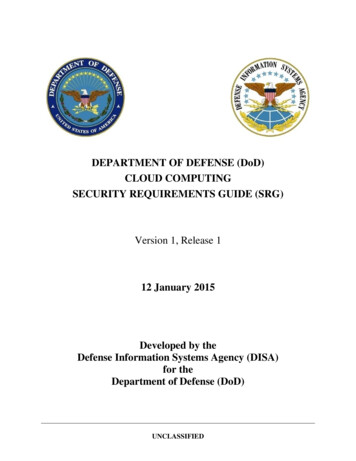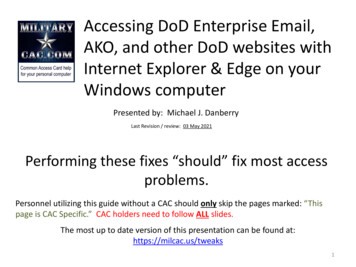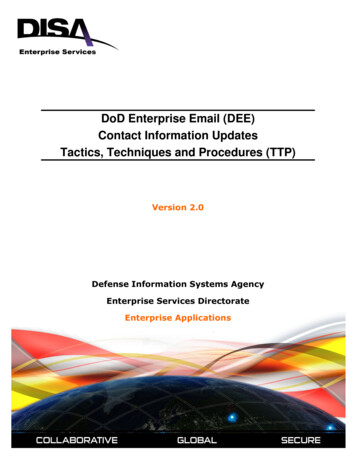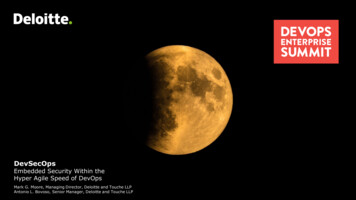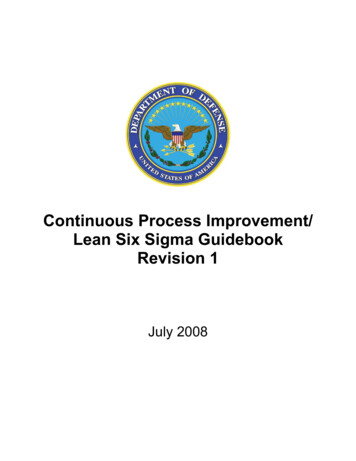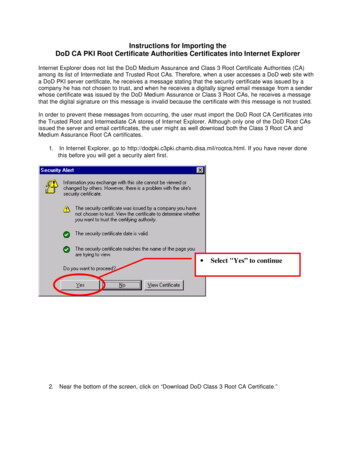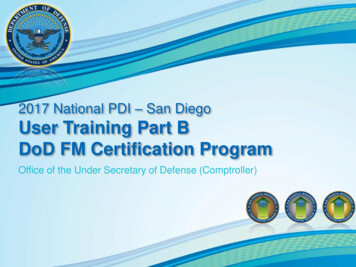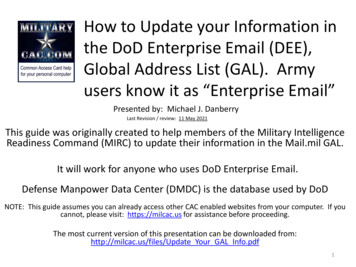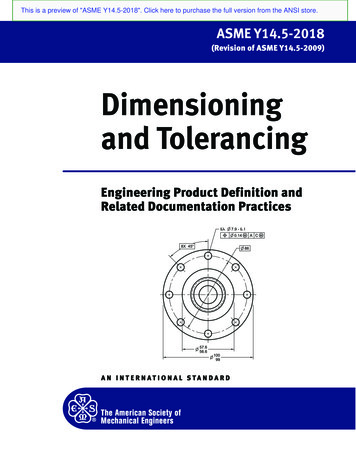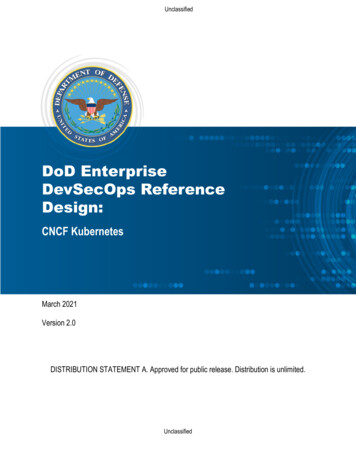
Transcription
UnclassifiedUNCLASSIFIEDDoD EnterpriseDevSecOps ReferenceDesign:CNCF KubernetesMarch 2021Version 2.0DISTRIBUTION STATEMENT A. Approved for public release. Distribution is unlimited.UNCLASSIFIEDUnclassified1
UNCLASSIFIEDDocument Set ReferenceUNCLASSIFIED2
UNCLASSIFIEDDocument ApprovalsApproved by:signed byCHAILLAN.NICOL DigitallyCHAILLAN.NICOLAS.MAXIME.AS.MAXIME.1535 1535056524Date: 2021.05.04 10:28:37056524-04'00'Nicolas ChaillanChief Software Officer, Department of Defense, United States Air Force, SAF/AQUNCLASSIFIED3
UNCLASSIFIEDTrademark InformationNames, products, and services referenced within this document may be the trade names,trademarks, or service marks of their respective owners. References to commercial vendors andtheir products or services are provided strictly as a convenience to our readers, and do notconstitute or imply endorsement by the Department of any non-Federal entity, event, product,service, or enterprise.UNCLASSIFIED4
UNCLASSIFIEDContents1Introduction . 71.1Background. 71.2Purpose . 71.3DevSecOps Compatibility . 81.4Scope . 81.5Document Overview . 91.6What’s New in Version 2. 92Assumptions and Principles . 103Software Factory Interconnects . 10453.1Cloud Native Access Points . 113.2CNCF Certified Kubernetes . 113.3Locally Centralized Artifact Repository . 123.4Sidecar Container Security Stack (SCSS) . 133.5Service Mesh . 16Software Factory K8s Reference Design . 174.1Containerized Software Factory . 184.2Hosting Environment . 204.3Container Orchestration . 20Additional Tools and Activities . 225.1Additional Deployment Types. 295.1.1Blue/Green Deployments . 295.1.2Canary Deployments . 295.1.3Rolling Deployments . 295.1.4Continuous Deployments . 305.2Continuous Monitoring in K8s . 305.2.1CSP Managed Services for Continuous Monitoring . 31UNCLASSIFIED5
UNCLASSIFIEDFiguresFigure 1: Kubernetes Reference Design Interconnects . 11Figure 2: Container Orchestrator and Notional Nodes . 12Figure 3: Sidecar Container Relationship to Application Container . 13Figure 4: Software Factory Implementation Phases. 17Figure 5: Containerized Software Factory Reference Design . 20Figure 6: DevSecOps Platform Options . 21Figure 7: Software Factory - DevSecOps Services . 22Figure 8: Logging and Log Analysis Process . 31TablesTable 1 Sidecar Security Monitoring Components. 15Table 2: CD/CD Orchestrator Inputs/Outputs. 18Table 3: Security Activities Summary and Cross-Reference. 23Table 4: Develop Phase Activities . 23Table 5: Build Phase Tools. 23Table 6: Build Phase Activities. 24Table 7: Test Phase Tools . 24Table 8: Test Phase Activities . 25Table 9: Release and Deliver Phase Tools . 25Table 10: Release and Deliver Phase Activities . 25Table 11: Deploy Phase Tools . 26Table 12: Deploy Phase Activities . 27Table 13: Operate Phase Activities. 27Table 14: Monitor Phase Tools . 28Table 15: CSP Managed Service Monitoring Tools . 28UNCLASSIFIED6
UNCLASSIFIED1 Introduction1.1 BackgroundModern information systems and weapons platforms are driven by software. As such, the DoDis working to modernize its software practices to provide the agility to deliver resilient software atthe speed of relevance. DoD Enterprise DevSecOps Reference Designs are expected toprovide clear guidance on how specific collections of technologies come together to form asecure and effective software factory.1.2 PurposeThis DoD Enterprise DevSecOps Reference Design is specifically for Cloud Native ComputingFoundation (CNCF) Certified Kubernetes implementations. This enables a Cloud agnostic,elastic instantiation of a DevSecOps factory anywhere: Cloud, On Premise, Embedded System,Edge Computing.For brevity, the use of the term ‘Kubernetes’ or ‘K8s’ throughout the remainder of thisdocument must be interpreted as a Kubernetes implementation that properly submittedsoftware conformance testing results to the CNCF for review and correspondingcertification. The CNCF lists over 90 Certified Kubernetes offerings that meet softwareconformation expectations. 1It provides a formal description of the key design components and processes to provide arepeatable reference design that can be used to instantiate a DoD DevSecOps SoftwareFactory powered by Kubernetes. This reference design is aligned to the DoD EnterpriseDevSecOps Strategy, and aligns with the baseline nomenclature, tools, and activities defined inthe DevSecOps Fundamentals document and its supporting guidebooks and playbooks.The target audiences for this document include: DoD Enterprise DevSecOps capability providers who build DoD Enterprise DevSecOpshardened containers and provide a DevSecOps hardened container access service. DoD Enterprise DevSecOps capability providers who build DoD Enterprise DevSecOpsplatforms and platform baselines and provide a DevSecOps platform service. DoD organization DevSecOps teams who manage (instantiate and maintain)DevSecOps software factories and associated pipelines for its programs. DoD program application teams who use DevSecOps software factories to develop,secure, and operate mission applications. Authorizing Officials (AOs).This reference design aligns with these reference documents:1Cloud Native Computing Foundation, “Software conformance (Certified Kubernetes,” [ONLINE] re-conformance/. [Accessed 8 February 2021].UNCLASSIFIED7
UNCLASSIFIED DoD Digital Modernization Strategy.2 DoD Cloud Computing Strategy.3 DISA Cloud Computing Security Requirements Guide.4 DISA Secure Cloud Computing Architecture (SCCA).5 Presidential Executive Order on Strengthening the Cybersecurity of Federal Networksand Critical Infrastructure (Executive Order (EO) 1380).6 National Institute of Standards and Technology (NIST) Cybersecurity Framework.7 NIST Application Container Security Guide.8 Kubernetes (draft) STIG – Ver 1.9 DISA Container Hardening Process Guide, V1R1.101.3 DevSecOps CompatibilityThis reference design asserts version compatibility with these supporting DevSecOpsdocuments: DoD Enterprise DevSecOps Strategy Guide, Version 2.0. DevSecOps Tools and Activities Guidebook, Version 2.0.1.4 ScopeThis reference design is product-agnostic and provides execution guidance for use by softwareteams. It is applicable to developing new capabilities and to sustaining existing capabilities inboth business and weapons systems software, including business transactions, C3, embeddedsystems, big data, and Artificial Intelligence (AI).This document does not address strategy, policy, or acquisition.2DoD CIO, DoD Digital Modernization Strategy, Pentagon: Department of Defense, 2019.3Department of Defense, "DoD Cloud Computing Strategy," December 2018.4DISA, “Department of Defense Cloud Computing Security Requirements Guide, v1r3,” March 6, 20175DISA, "DoD Secure Cloud Computing Architecture (SCCA) Functional Requirements," January 31, 2017.6White House, "Presidential Executive Order on Strengthening the Cybersecurity of Federal Networks and CriticalInfrastructure (EO 1380)," May 11, 2017.7National Institute of Standards and Technology, Framework for Improving Critical Infrastructure Cybersecurity,2018.8NIST, "NIST Special Publication 800-190, Application Container Security Guide," September 2017.9DoD Cyber Exchange, “Kubernetes Draft STIG – Ver 1, Rel 0.1,” December 15, 2020.10DISA, “Container Hardening Process Guide, V1R1,” October 15, 2020UNCLASSIFIED8
UNCLASSIFIED1.5 Document OverviewThe documentation is organized as follows: Section 1 describes the background, purpose and scope of this document. Section 2 identifies the assumptions relating to this design. Section 3 describes the DevSecOps software factory interconnects unique to aKubernetes reference design. Section 4 describes the containerized software factory design. Section 5 captures the additional required and preferred tools and activities, buildingupon the DevSecOps Tools and Activities Guidebook as a baseline.1.6 What’s New in Version 2 Refactored the document’s overall structure to align with the shift to a DevSecOpsDocument Set approach.UNCLASSIFIED9
UNCLASSIFIED2 Assumptions and PrinciplesThis reference design makes the following assumptions: No specific Kubernetes implementation is assumed, but the selected Kubernetesimplementation must have submitted conformance testing results for review andcertification by the CNCF. Vendor lock-in is avoided by mandating a Certified Kubernetes implementation;however, product lock-in into the Kubernetes API and its overall ecosystem is openlyrecognized.It is critically important to avoid the proprietary APIs that are sometimes addedby vendors on top of the existing CNCF Kubernetes APIs. These APIs are notportable and may create vendor lock-in! Adoption of hardened containers as a form of immutable infrastructure results instandardization of common infrastructure components that achieve consistent andpredictable results. This reference design depends upon a number of DoD Enterprise Services, which will benamed throughout this document.3 Software Factory InterconnectsThe DevSecOps Fundamentals describes a DevSecOps platform as a multi-tenet environmentconsisting of three distinct layers: Infrastructure, Platform/Software Factory, and Application(s).Each reference design is expected to identify its unique set of tools and activities that exist atthe boundaries between the discrete layers, known as Reference Design Interconnects. Welldefined interconnects in a reference design enable tailoring of the software factory design, whileensuring that core capabilities of the software factory remain intact.Figure 1: Kubernetes Reference Design Interconnects identifies the specific Kubernetesinterconnects that must be present in order to be compliant with this reference design. Thespecific interconnects include: Cloud Native Access Point (CNAP) above the Infrastructure layer to manage all northsouth network traffic. Use of Kubernetes in each of the development environments. Clear identification of a locally centralized artifact repository to host hardened containersfrom Iron Bank, the DoD Centralized Artifact Repository (DCAR) of hardened andcentrally accredited containers.UNCLASSIFIED10
UNCLASSIFIED Use of a service mesh within the K8s orchestrator to manage all east-west networktraffic. Mandatory adoption of the Sidecar Container Security Stack (SCSS) to implement zerotrust down to the container/function level, also providing behavior protection.Each of these interconnects will be described fully next.Figure 1: Kubernetes Reference Design Interconnects3.1 Cloud Native Access PointsA Cloud Native Access Point (CNAP) provides a zero-trust architecture on Cloud One to provideaccess to development, testing, and production enclaves at Impact Level 2 (IL-2), Impact Level4 (IL-4), and Impact Level 5 (IL-5).11 CNAP provides access to Platform One DevSecOpsenvironments by using an internet-facing Cloud-native zero trust environment. CNAP’s zerotrust architecture facilitates development team collaboration from disparate organizations. (ACNAP reference design is forthcoming.)3.2 CNCF Certified KubernetesKubernetes is a container orchestrator that manages the scheduling and execution of OpenContainer Initiative (OCI) compliant containers across multiple nodes, depicted in Figure 2. OCIis an open governance structure for creating open industry standards around both container11DISA, “Department of Defense Cloud Computing Security Requirements Guide, v1r3,” Mar 6, 2017UNCLASSIFIED11
UNCLASSIFIEDformats and runtimes.12 The container is the standard unit of work in this reference design.Containers enable software production automation in this reference design, and they also allowoperations and security process orchestration.Figure 2: Container Orchestrator and Notional NodesKubernetes provides an API that ensures total abstraction of orchestration, compute, storage,networking, and other core services that guarantees software can run in any environment, fromthe Cloud to embedded inside of platforms like jets or satellites.The key benefits of adopting Kubernetes include: Multimodal Environment: Code runs equally well in a multitude of computeenvironments, benefitting from the K8s API abstraction. Baked-In Security: The Sidecar Container Security Stack is automatically injected intoany K8s cluster with zero trust. Resiliency: Self-healing of unstable or crashed containers. Adaptability: Containerized microservices create highly-composable ecosystems. Automation: Fundamental support for a GitOps model and IaC speed processes andfeedback loops. Scalability: Application elasticity to appropriately scale and match service demand.The adoption of K8s and OCI compliant containers are concrete steps towards truemicroservice reuse, providing the Department with a compelling ability to pursue higher ordersof code reuse across an array of programs.3.3 Locally Centralized Artifact RepositoryA Locally Centralized Artifact Repository is a local repository tied to the software factory. Itstores artifacts pulled from Iron Bank, the DoD repository of digitally signed binary containerimages that have been hardened. The local artifact repository also likely stores locallydeveloped artifacts used in the DevSecOps processes. Artifacts stored here include, but are not12The Linux Foundation Projects, “Open Container Initiative,” [Online] Available at: https://opencontainers.org.UNCLASSIFIED12
UNCLASSIFIEDlimited to, container images, binary executables, virtual machine (VM) images, archives, anddocumentation.The Iron Bank artifact repository provides hardened, secure technical implementation guide(STIG) compliance, and centrally updated, scanned, and signed containers that increases thecyber survivability of these software artifacts. At time of writing this reference design, over 300artifacts were in Iron Bank, with more being added continuously.Programs may opt for a single artifact repository and rely on the use of tags to distinguishbetween the different content types. It is also permissible to have separate artifact repositoriesto store local artifacts and released artifacts.3.4 Sidecar Container Security Stack (SCSS)The cyber arena is an unforgiving hostile environment where even a minute exposure andcompromise can lead to catastrophic failures and loss of human life. Industry norms nowrecognize that a modern holistic cybersecurity posture must include centralized logging andtelemetry, zero trust ingress/egress/east-west network traffic, and behavior detection at aminimum.A cybersecurity stack is frequently updated as threat conditions evolve. A key benefit of acybersecurity K8s sidecar container design is rapidly deployed updates without anyrecompilation or rebuild required of the microservice container itself. To support this approach,the SCSS is available from the Iron Ban repository as a hardened container that K8sautomatically injects into each container group (pod). This decoupled architecture, shown inFigure 3, speeds deployment of an updated cyber stack without requiring any type of reengineering by development teams.Figure 3: Sidecar Container Relationship to Application ContainerAs shown in Figure 3, the sidecar can share state with the application container. In particular,the two containers can share disk and network resources while their running components arefully isolated from one another.UNCLASSIFIED13
UNCLASSIFIEDThe complete set of sidecar container security monitoring components are captured in Table 1on the next page. Capability highlights include: Centralized logging and telemetry that includes extract, transform, and load (ETL)capabilities to normalize log data. Robust east/west network traffic management (whitelisting). Zero Trust security model. Whitelisting. Role-Based Access Control. Continuous Monitoring. Signature-based continuous scanning using Common Vulnerabilities and Exposures(CVEs). Runtime behavior analysis. Container policy enforcement.UNCLASSIFIED14
UNCLASSIFIEDTable 1 Sidecar Security Monitoring ComponentsToolFeaturesBenefitsLogging agentSend logs to a logging serviceLogging Storage andRetrieval ServiceLog visualization andanalysisContainer policyenforcementStores logs and allows searching logsRuntime DefenseService Mesh proxyService MeshVulnerabilityManagementCVE Service / HostBased SecurityArtifact RepositoryZero Trust modeldown to thecontainer levelAbility to visualize log data in various waysand perform basic log analysis.Support for Security Content AutomationProtocol (SCAP) and container configurationpolicies. These policies can be defined asneeded.Creates runtime behavior models, includingwhitelist and least privilegeTies to the Service Mesh. Used with amicroservices architecture.Used for a microservices architectureProvides vulnerability managementProvides CVEs. Used by the vulnerabilitymanagement agent in the security sidecarcontainer.Storage and retrieval for artifacts such ascontainers.Provides strong identities per Pod withcertificates, mTLS tunneling and whitelistingof East-West traffic down to the Pod level.BaselineREQUIREDStandardize log collection to a centrallocation. This can also be used to sendnotifications when there is anomalousbehavior.Place to store logsREQUIREDHelps to find anomalous patternsPREFERREDAutomated policy enforcementREQUIREDDynamic, adaptive cybersecurityREQUIREDEnables use of the service mesh.REQUIREDBetter microservice management.Makes sure everything is properly patchedto avoid known vulnerabilitiesMakes sure the system is aware of knownvulnerabilities in components.REQUIREDREQUIREDOne location to obtain hardened artifactssuch as containersReduces attack surface and improvesbaked-in securityREQUIREDUNCLASSIFIEDREQUIREDREQUIRED15
UNCLASSIFIED3.5 Service MeshA service mesh enhances cybersecurity by controlling how different parts of an applicationinteract. It is a dedicated infrastructure layer baked-in to the software application itself; it is not a“bolt-on” component. Some of the specific capabilities of a service mesh in K8s includingmonitoring east-west network traffic, routing traffic based on a declarative network traffic modelthat can deny all network traffic by default, and dynamically injecting strong certificate-basedidentities without requiring access to the underlying code that built the software container. Aservice mesh also typically takes over ownership of the iptables in order to inject an mTLStunnel with FIPS compliant cryptographic algorithms to further protect all data in motion.Service mesh integration into the K8s cluster reduces the cyber-attack surface, and whencoupled with behavior detection, it can proactively kill any container that is drifting outside of itsexpected operational norms. These capabilities restrict the ability of a bad actor to laterallymove around within the K8s cluster and fully eliminate the ability of the bad actor to achieveescalated privileges. For these reasons, service mesh integration is a powerful component inensuring the cyber survivability of the software factory and the containerized applicationsproduced by the factory’s pipelines.UNCLASSIFIED16
UNCLASSIFIED4 Software Factory K8s Reference DesignThis section will discuss the software factory design required for this reference design. It isbased on the DoD Enterprise DevSecOps Container Service offering to create a softwarefactory using DevSecOps tools from hardened containers stored in Iron Bank.All software factory implementations follow the DevSecOps philosophy and go through fourunique phases: Design, Instantiate, Verify, Operate & Monitor. Figure 4 illustrates the phases,activities, and the relationships with the application lifecycle. Security is applied across allsoftware factory phases. The SCSS must be used for cybersecurity monitoring of the factory inthis reference design.Figure 4: Software Factory Implementation PhasesThe components of this reference design’s software factory must be instantiated as follows: ACSP-agnostic solution running a CNCF Certified K8s using hardened containers from Iron Bank.This design recognizes that K8s is well-suited to act as the engine powering a continuousintegration/continuous delivery (CI/CD) orchestrator, coordinating multiple parallel DevSecOpspipelines. K8s manages pipeline creation, pipeline modification, overall pipeline execution, andfinally pipeline termination.The software factory leverages technologies and tools to automate the CI/CD pipelineprocesses defined in the DevSecOps lifecycle plan phase. There are no “one size fits all” orhard rules about what CI/CD processes should look like and what tools must be used. Eachsoftware team needs to embrace the DevSecOps culture and define processes that suit itssoftware system architectural choices. The tool chain selection is specific to the softwareprogramming language choices, application type, tasks in each software lifecycle phase, andthe system deployment platform.DevSecOps teams create a pipeline workflow in the CI/CD orchestrator by specifying a set ofstages, stage conditions, stage entrance and exit control rules, and stage activities. The CI/CDUNCLASSIFIED17
UNCLASSIFIEDorchestrator automates the pipeline workflow by validating the stage control rules. If all theentrance rules of a stage are met, the orchestrator will transition the pipeline into that stage andperform the defined activities by coordinating the tools via plugins. If all the exit rules of thecurrent stage are met, the pipeline exits out the current stage and starts to validate the entrancerules of the next stage. Table 2 shows the features, benefits, and inputs and outputs of theCI/CD orchestrator.Table 2: CD/CD Orchestrator eorchestrator pipelineworkflowCustomizable Human inputpipelineabout:solution A set ofstages A set ofeventtriggers Each stageentrance andexit controlgate Activities ineach stageOrchestrate Automate the Event triggersCI/CD tasks; (such as codepipelineAuditable trail commit, testworkflowof activitiesresults, humanexecutioninput, etc.);byArtifacts from thecoordinatingartifactother pluginrepositorytools lineREQUIREDPipelineworkflowexecutionresults (suchas ution,etc.);Event andactivity auditlogs4.1 Containerized Software FactorySoftware factory tools include a CI/CD orchestrator, a set of development tools, and a group oftools that operate in different DevSecOps lifecycle phases. These tools are pluggable and mustintegrate into the CI/CD orchestrator. In this reference design, instantiations must rely acontainerized software factory instantiated from a set of DevSecOps hardenedcontainers accessed directly from Iron Bank. Iron Bank containers are preconfigured andsecured to reduce the certification and accreditation burden and are often available as apredetermined pattern or pipeline that will need limited or no configuration.UNCLASSIFIED18
UNCLASSIFIEDRunning a CI/CD pipeline is a complex activity. Containerization of the entire CI/CD stackensures there is no drift possible between different K8s cluster environments (development,test, staging, production). It further ensures there is no drift between different K8s clusterenvironments spanning multiple classification levels. Containerization also streamlines theupdate/accreditation process associated with the introduction and adoption of new DevSecOpstooling.Figure 5, illustrates a containerized software factory reference design. The software factory isbuilt on an underlying container orchestration layer powered by K8s in a host environment. Forclarity, the software factory produces DoD applications and application artifacts as a product.Applications typically use different sets of hardened containers from the Iron Bank than the onesused to create the software factory.The software factory reference design captured in Figure 5 illustrates how cybersecurity isweaved into the fabric of each factory pipeline. All of the tooling within the factory is based onhardened containers pulled from Iron Bank.Moving from left to right, as code is checked into a branch triggering the CI/CD pipelineworkflow and resulting automated build, SAST, DAST, and unit tests are executed, as theorchestrator coordinates different tools to perform various tasks defined by the pipeline. If thebuild is successful and a container image is defined, a container security scan is triggered.Some tests and security tasks may require human involvement or consent before beingconsidered complete and passed. If all of these tests are successful, then the artifact isdeployed into the test environment. If all of the entrance rules of the next stage are met, theorchestrator will transition the pipeline into that stage and perform the defined activities bycoordinating the tools via plugins. When all stages are complete, a significant number ofsecurity activities have completed and the artifact is eligible for deployment into production.Deployment into production should be fully automated, but may be gated by a human actuallypressing a button to trigger the deployment.UNCLASSIFIED19
UNCLASSIFIEDFigure 5: Containerized Software Factory Reference DesignDoD programs may have already implemented a DevSecOps platform. Operating a customDevSecOps platform is an expensive endeavor because software factories require the samelevel of continuous investment as a software application. There are financial benefits forprograms to plan a migration to a containerized software factory, reaping the benefits ofcentrally managed and hardened containers that have been fully vetted. In situations where acontainerized software factory is impractical, or the factory requires extensive policycustomizations, the program should consult with DoD CIO and (if applicable) its ownDevSecOps program office to explore o
Feb 08, 2021 · Figure 7: Software Factory - DevSecOps Services. 22 Figure 8: Logging and Log Analysis Process . Cloud Native Access Point (CNAP) above the Infras
